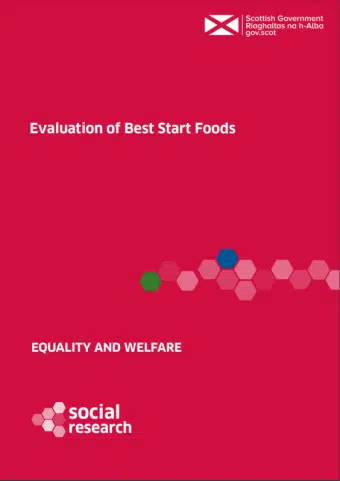21st September 2022
This summer, the Scottish Government published their Best Start Foods evaluation report which contains transferable learning that will be of interest to all UK nations and those working to improve access to nutritious foods for low income families. This report presents an evaluation of the benefit of the programme and its contribution to the Scottish Government’s immediate and short-term policy outcomes and their long-term aims (e.g. reduced health inequalities).
The Social Security (Scotland) Act 2018 introduced a range of new benefits devolved to Scotland, including Best Start Foods which replaced the UK Healthy Start Vouchers in Scotland in August 2019. Best Start Foods is designed to provide financial support for low-income families and help them to access nutritious food at the point of need.
Best Start Foods is delivered via a payment card, which can be used like a normal bank card with contactless or Chip & Pin features. The payment amounts are:
- £4.50 per week for pregnant women and families with children aged 1 and 2
- £9.00 per week for families with children aged under 1, to support both the mother and the child.
To maximise take-up of the benefit, the application form is part of a joint application for both Best Start Foods and Best Start Grant. People can also choose to apply for Scottish Child Payment using the same form.
Best Start Foods evaluation findings
The Best Start Foods evaluation findings are based on qualitative research that was commissioned and undertaken by ScotCen. This involved interviews with Best Start Foods recipients, healthcare professionals who support applicants, and retailers who participate in the Best Start Foods scheme. It also draws on Official Statistics and a survey of benefits applicants which was undertaken by Social Security Scotland.
The evaluation considered the policy outcomes of Best Start Foods in relation to the benefit’s impact on people who receive the payments in relation to:
- Promotion and take-up of Best Start Foods
- Understanding and knowledge of Best Start Foods
- Improving the application process for Best Start Foods.
There are two reports – the main evaluation and the Annex report (both available on this link).
Key findings from the report include:
- Over the period April 2020 to June 2021, take-up of Best Start Foods was estimated to be 77%.
- Overall, recipients prefer Best Start Foods to the previous Healthy Start Vouchers system, because they feel the payment card is more discreet. They feel less embarrassed and stigmatised using the card in shops.
- Recipients report that Best Start Foods can be used in more shops than Healthy Start Vouchers. This enables recipients to shop around and find the lowest prices.
- Recipients also report that the card is easier to use and more convenient than vouchers because it facilitates contactless payments and the ability to self-checkout in shops. People who do not speak English also prefer it because the format is familiar to them, and they do not need to speak or read English to use it.
- The qualitative evidence suggests that people use it to mainly buy cow’s milk, baby formula, fresh fruit, and vegetables. Some also use it for other recommended items (for example: eggs, pulses, and frozen or tinned fruit and vegetables).
- The evaluation also shows that recipients purchase healthier snacks for their children, instead of processed foods like crisps, and some use payments to experiment with new healthy recipes.
- Recipients also mentioned other positive health and wellbeing impacts of Best Start Foods, including observing their children eating more fruit and vegetables, which they feel is good for them nutritionally and supports their development.
Despite these positive outcomes, some recipients have reported challenges, some of which include:
- Recipients finding it difficult to afford the same number of healthy foods when their children turn 1, and they return to the lower rate of Best Start Foods.
- Healthcare professionals raising concerns about reducing payments when children turn 1, and the impact it will have on healthy food shopping.
- Some recipients experiencing difficulties using the Best Start Foods card for the first time because it is not yet activated. Some also report that contactless payments do not work on their card, meaning they must use Chip & Pin.
- While recipients appreciate the financial support offered by Best Start Foods, they feel the impact would be greater if eligibility was extended until their child starts school. Some recipients share that they would find it difficult to cover the costs of nutritious food after Best Start Foods comes to an end.
The evaluation shows that Best Start Foods has largely achieved its immediate and short-term policy outcomes (which were: Promotion and take-up of Best Start Foods; Understanding and knowledge of Best Start Foods; and improving the application process) and has made progress towards its medium-term policy outcomes. It is therefore likely to have contributed positively to the Scottish Government’s long-term aims (such as reduced health inequalities and reduced child poverty).
The report concludes with 10 policy implications which can be found here.


